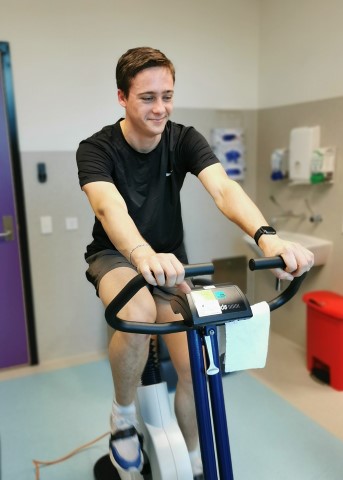
Exercise and hypo awareness study
Usually people with type 1 diabetes (T1D) know when their blood glucose level is going low by showing symptoms like becoming pale and shaky. This is called hypoglycaemia awareness, or hypo awareness.
However, some people with T1D are not able to feel their symptoms and so they may be at a higher risk of having a severe hypo.
Avoiding hypos for several weeks can improve hypo awareness, but this often means running blood glucose levels quite high for a while, which is not an ideal solution.
We want to see if introducing a home-based exercise program (either continuous low-intensity, or intermittent high-intensity cycling, three times per week) is practical, can improve hypo awareness, improve your glucose levels and reduce hypos for individuals living with T1D who have impaired hypo awareness.
Who can participate?
We are looking for:
- individuals living with type 1 diabetes aged 14-35 years;
- who have impaired hypo awareness;
- do not regularly participate in high-intensity exercise;
- own an iOS (Apple) or Android phone; and
- willing to use a Dexcom continuous glucose monitoring (CGM) system and a Garmin exercise-monitoring watch during the trial period.
What does it involve?
The entire study will run over 18 weeks in total and will be completed at home. There is no need for you to come to PCH.
The study is split into four phases. Phase 1 goes for two weeks and is to help you to become familiar with the CGM system if you have not used it before. We will visit you at home to deliver the exercise bike and exercise monitoring watch. We will show you how to use the stationary exercise bike that you will use throughout the study, ask you to complete some questionnaires about your hypo awareness and physical activity, and provide you with a hypo\ symptom diary to record your hypos.
Phase 2 goes for four weeks and will be your first 4-week exercise program. We will give you a call to start Phase 2 and a researcher may be in contact to ensure that the activity-watch is correctly recording your exercise sessions throughout the 4 weeks. In the last two weeks of Phase 2, we will ask you to complete another hypo symptom diary and a few more questionnaires.
Phase 3 goes for eight weeks and is a break or ‘washout’ period before you start your second 4-week exercise program. We would still like you to continue to use the Dexcom CGM system (and exercise watch), so we will provide you with a fresh supply of sensors, but ask that you only continue to complete the type and level of exercise that you did before starting in the study. In the last two weeks of this phase, we would again like you to complete another hypo symptom diary.
Phase 4 of the study involves the second 4-week exercise program. It is identical to Phase 2, except that if you completed the intermittent high-intensity program first, you will complete the low-intensity program during this phase and vice-versa.
At the end of Phase 4, the study is complete and we will return to your home to collect the exercise bike and activity watch.
How can I find out more?
If you would like more information please download the study information sheets below:
If you have any further questions or would like to participate, please contact Dr Mary Abraham at diabetes.research@health.wa.gov.au
